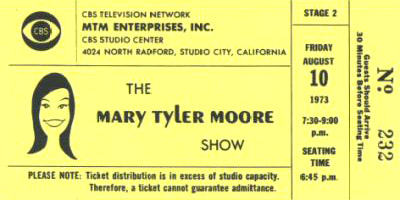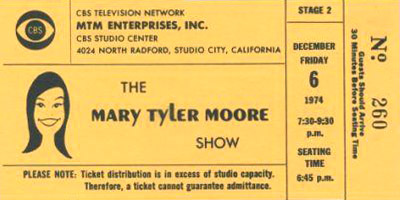Mary Tyler Moore Show, The


If you’d attended a filming of Ms. Moore’s classic sitcom — and sadly, I never did — you would probably have heard a warm-up performed by writer Lorenzo Music, who later gained fame as the voice of Carlton the Doorman (on Rhoda) and Garfield the Cat. For a time, shows produced by the MTM company dominated CBS Studio Center in the valley — a facility built on land that had once housed Mack Sennett’s second studio. Sennett erected it just as his business was dying out due to changing audience tastes, as well as the coming of sound film. The property was sold in a bankruptcy hearing and went through several owners before becoming Republic Studios, birthplace of many a movie serial and “B” western. It had moved into renting out space to others by 1963 when CBS leased the place, eventually buying it outright.
The Mary Tyler Moore Show was the sitcom that changed seventies’ television. As is well known, the network was not fond of the script and format devised by writers James Brooks and Allan Burns, and the advance testing of the show predicted a sure-fire flop. Less well known is how the show came to be at all. After The Dick Van Dyke Show, Mary Tyler Moore had attempted to establish a motion picture career. Thoroughly Modern Millie was a modest success but then What’s So Bad About Feeling Good? and Don’t Just Stand There suggested that ticket buyers were not racing to see Laura Petrie on the big screen. A disastrous attempt at a Broadway musical (Breakfast at Tiffany’s) also helped convince her that her place was on television. And what really convinced her (and CBS) was a 1969 special in which she reteamed with her former co-star. Dick Van Dyke and the Other Woman was an hour of songs and sketches that earned rave reviews and strong ratings.
It got Mary the offer she needed to return to the world of situation comedy and soon, she not only had a hit show but a production company that produced many of them, including spin-offs Rhoda and Phyllis, as well as acclaimed, unrelated sitcoms including The Bob Newhart Show, WKRP in Cincinnatti, The Tony Randall Show and many more. After The Mary Tyler Moore Show left the air in 1977, she again tried movies and Broadway with mixed success but again fled back to television. She starred in Mary (1978), The Mary Tyler Moore Hour (1979) and another show called Mary (1985).






